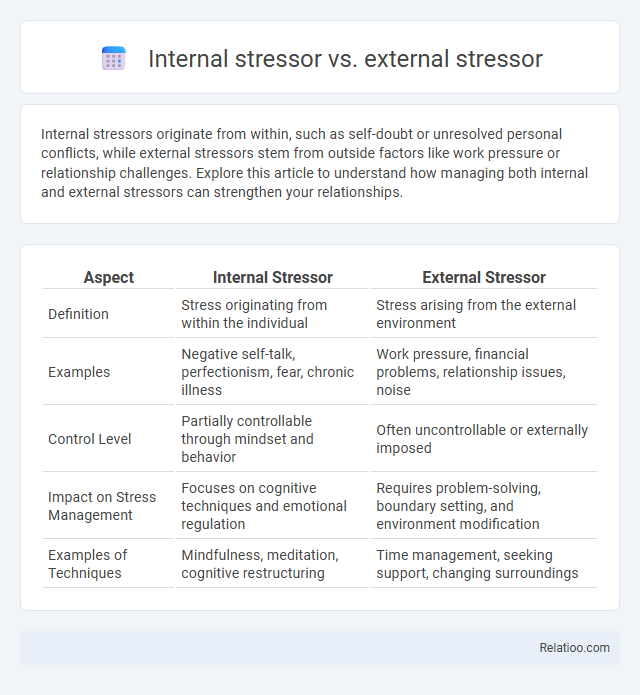Internal stressors originate from within, such as self-doubt or unresolved personal conflicts, while external stressors stem from outside factors like work pressure or relationship challenges. Explore this article to understand how managing both internal and external stressors can strengthen your relationships.
Table of Comparison
| Aspect | Internal Stressor | External Stressor |
|---|---|---|
| Definition | Stress originating from within the individual | Stress arising from the external environment |
| Examples | Negative self-talk, perfectionism, fear, chronic illness | Work pressure, financial problems, relationship issues, noise |
| Control Level | Partially controllable through mindset and behavior | Often uncontrollable or externally imposed |
| Impact on Stress Management | Focuses on cognitive techniques and emotional regulation | Requires problem-solving, boundary setting, and environment modification |
| Examples of Techniques | Mindfulness, meditation, cognitive restructuring | Time management, seeking support, changing surroundings |
Understanding Internal and External Stressors
Internal stressors originate from within an individual, such as anxiety, negative self-talk, or physical illness, influencing emotional and mental well-being. External stressors arise from environmental factors like job pressure, relationship conflicts, or financial difficulties, impacting behavior and coping mechanisms. Understanding the distinction between internal and external stressors helps in developing targeted strategies for stress management and improving overall resilience.
Defining Internal Stressors
Internal stressors originate from within an individual, including emotions, thoughts, and physiological conditions such as anxiety, self-doubt, or chronic illness. External stressors arise from environmental factors like work pressure, social relationships, or financial difficulties. Understanding internal stressors is crucial for effective stress management as they involve personal perceptions and reactions that influence overall mental health.
Defining External Stressors
External stressors are environmental or situational factors outside an individual that trigger stress responses, including job demands, social conflicts, and major life changes. Internal stressors originate within the person, such as negative self-talk or chronic illness, while stressors broadly encompass any stimulus causing psychological or physiological strain. Understanding external stressors is crucial for effective stress management and intervention strategies.
Key Differences Between Internal and External Stressors
Internal stressors originate from within your mind or body, such as self-doubt, illness, or personal beliefs, directly influencing your emotional and physical state. External stressors arise from outside factors like work demands, social pressures, or environmental challenges, impacting your daily environment and interactions. Understanding the key differences between internal and external stressors helps you develop targeted coping strategies to manage stress effectively.
Common Examples of Internal Stressors
Internal stressors originate within your mind or body, including emotions, thoughts, and physical conditions such as chronic pain or illness. Common examples of internal stressors are anxiety, self-doubt, and negative self-talk that affect your mental state. External stressors come from your environment or external events, like work pressure, relationship conflicts, or financial problems, creating stress outside your control.
Typical Examples of External Stressors
External stressors typically include factors such as financial problems, work pressure, relationship conflicts, and environmental changes like noise or extreme weather. Unlike internal stressors, which originate from within your thoughts and emotions, external stressors come from outside events or situations that challenge your ability to cope. Understanding these typical examples of external stressors can help you develop strategies to manage stress effectively.
Effects of Internal Stressors on Mental Health
Internal stressors, such as negative self-talk and internal conflicts, significantly impact mental health by contributing to anxiety, depression, and low self-esteem. These stressors often trigger chronic stress responses, leading to hormonal imbalances and impaired cognitive function. Unlike external stressors, internal ones originate within the individual, intensifying feelings of helplessness and emotional distress.
Impact of External Stressors on Daily Life
External stressors, such as work pressure, social conflicts, and environmental noise, significantly impact daily life by triggering physiological and psychological responses like increased cortisol levels and anxiety. Unlike internal stressors, which stem from personal thoughts and emotions, external stressors originate outside the individual but can influence behavior, sleep quality, and overall mental health. Managing external stressors effectively is essential for maintaining productivity, emotional balance, and physical well-being in everyday routines.
Coping Strategies for Internal Stressors
Internal stressors originate from within an individual, such as negative self-talk, perfectionism, or unresolved emotions, requiring coping strategies centered on mindfulness, cognitive restructuring, and emotional regulation. Effective approaches include practicing self-awareness techniques, engaging in relaxation exercises, and seeking therapy or counseling to address underlying thoughts and feelings. External stressors, by contrast, stem from environmental factors like work pressure or social conflicts, where coping often involves problem-solving, time management, and social support.
Managing External Stressors Effectively
Managing external stressors effectively involves identifying and minimizing environmental pressures such as work demands, social conflicts, and financial challenges. Implementing practical coping strategies like time management, seeking social support, and setting realistic goals helps reduce the impact of external stressors on mental health. Differentiating external stressors from internal stressors, which originate from personal beliefs or emotions, enables targeted interventions that improve overall stress management.

Infographic: Internal stressor vs External stressor
 relatioo.com
relatioo.com